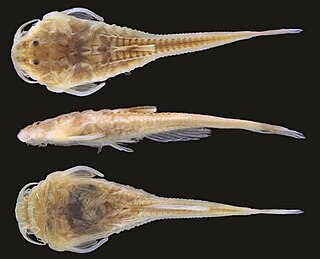
Catfish are a diverse group of ray-finned fish. Named for their prominent barbels, which resemble a cat's whiskers, catfish range in size and behavior from the three largest species alive, the Mekong giant catfish from Southeast Asia, the wels catfish of Eurasia, and the piraíba of South America, to detritivores, and even to a tiny parasitic species commonly called the candiru, Vandellia cirrhosa. Neither the armour-plated types nor the naked types have scales. Despite their name, not all catfish have prominent barbels or "whiskers". Members of the Siluriformes order are defined by features of the skull and swimbladder. Catfish are of considerable commercial importance; many of the larger species are farmed or fished for food. Many of the smaller species, particularly the genus Corydoras, are important in the aquarium hobby. Many catfish are nocturnal, but others are crepuscular or diurnal.

The Pimelodidae, commonly known as the long-whiskered catfishes, are a family of catfishes.

The Aspredinidae are a small South American family of catfishes also known as the banjo catfishes, with about 43 species.

Synodontis is the largest genus of mochokid catfishes. It is the biggest genus within the 10 genera and 190 different species in the family Mochokidae. Synodontis has over 131 different species within the genus. Synodontis are also known as squeakers, due to their ability to make stridulatory sounds through their pectoral fin spines when handled or disturbed. Synodontis make a sound that sounds like squeaking by rubbing their spines together. They do this when they have been frightened or when they become angry. Synodontis may also squeak when they are taken out of the water. These catfish are small- to medium-sized fish with many species exhibiting attractive spotted markings. Some species are also known for naturally swimming belly-up, earning the name upside-down catfish. Some of these species are Synodontis contractus and Synodontis nigriventris. While some of these species are known to swim upside down, another species, Synodontis multipunctatus, is a brood parasitic cuckoo catfish,there are two other species Synodontis petricola and Synodontis grandiops are also called brood parasitic cuckoo catfish.

Sisoroidea is a superfamily of catfishes. It contains the four families Amblycipitidae, Akysidae, Sisoridae, and Erethistidae; many sources also include Aspredinidae. With Aspredinidae, this superfamily includes about 42 genera and 230 species.

Chiloglanis is a genus of upside-down catfishes native to Africa. These species have modified lips and barbels that form a suckermouth. They also have a naked (scaleless) body. Sexual dimorphism has been reported in Chiloglanis. The adult males of many of these species have elongate anal and caudal fins. Also, males may have an enlarged humeral process.

Aspredo aspredo is the only species of banjo catfish in the genus Aspredo.
Acanthobunocephalus nicoi is one of two species of catfish in the genus Acanthobunocephalus of the family Aspredinidae. This species is known from only three localities and appears to be restricted to the upper Orinoco River system of Venezuela and possibly the upper Rio Negro system of Brazil.

Platystacus cotylephorus, the banded banjo, is a species of banjo catfish. It is the only member of its genus. The genus Platystacus is the sister group to a clade containing Aspredo and Aspredinichthys. P. cotylephorus originates from coastal waters and lower portions of rivers of northern South America, from Venezuela to northern Brazil.
Amaralia is a genus of catfish of the family Aspredinidae native to Amazon and Paraná-Paraguay basin. These species appear to be specialized to feed on the eggs of other catfishes; eggs found in Amaralia stomachs are thought to be those of loricariids.

Dupouyichthys sapito is the only species of banjo catfishes in the genus Dupouyichthys. This species appears to be restricted to the Magdalena and Maracaibo basins. D. sapito is a small, armored aspredinid, growing up to 27 millimetres (1.1 in) SL, distinguished from all other aspredinids by having only one set of paired pre-anal-fin plates. Also, the bony ornamentation of its skull is better developed than its close relatives. It is found in river banks with vegetation.
Aspredinichthys is a genus of banjo catfishes found in fresh and brackish waters in tropical South America from the Orinoco delta, through the Guianas, to the Amazon delta. Both species are found in lower portions of rivers and in coastal waters of northern South America from Venezuela to northern Brazil where they are benthic fish.
Ernstichthys is a genus of banjo catfishes that occurs in the Amazon and Orinoco basins.
Hoplomyzon is a genus of banjo catfishes that are native to tropical South America.
Xyliphius is a genus of banjo catfishes from South America.
Micromyzon akamai is a species of catfish in the family Aspredinidae.

Bunocephalus is a genus of banjo catfishes from South America. It is found in Magdalena, Orinoco, Amazon, Paraguay-Paraná, and São Francisco Rivers. It is also the only aspredinid genus found west of the Andes, found in the Atrato, San Juan, and Patía Rivers. This genus is a part of the family Aspredinidae, known as banjo catfishes for their large, flattened heads and slender tails that give the appearance of a banjo. Most species exhibit cryptic coloration, and the same holds true among Bunocephalus species. The skin is completely keratinized and is covered by large, unculiferous tubercles. Bunocephalus species may reach up to 13 centimetres SL.

Pseudobunocephalus is a genus of banjo catfishes.
Micromyzon orinoco is a species of catfish in the family Aspredinidae.

Hoplomyzon cardosoi, is a species of fish from the genus Hoplomyzon. The species was originally described by Tiago P. Carvalho, Roberto E. Reis and John P. Friel in 2017










